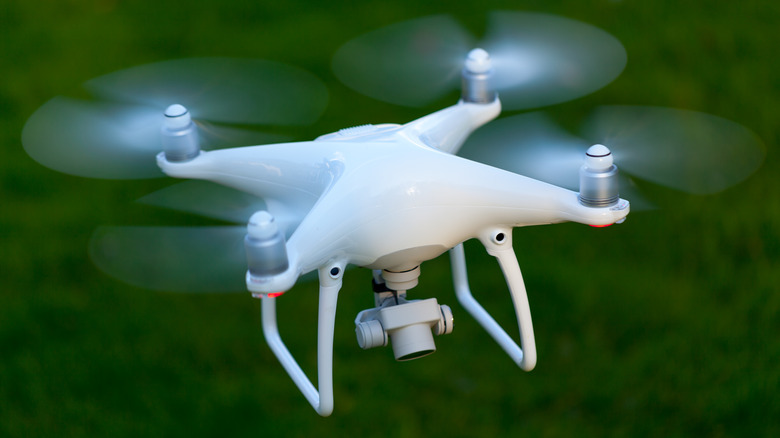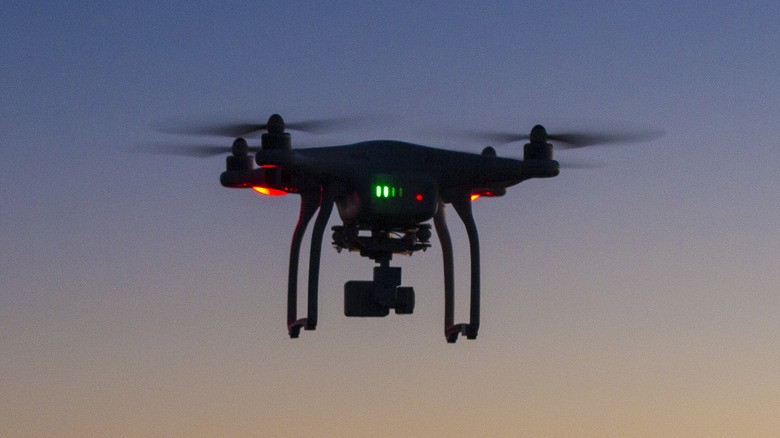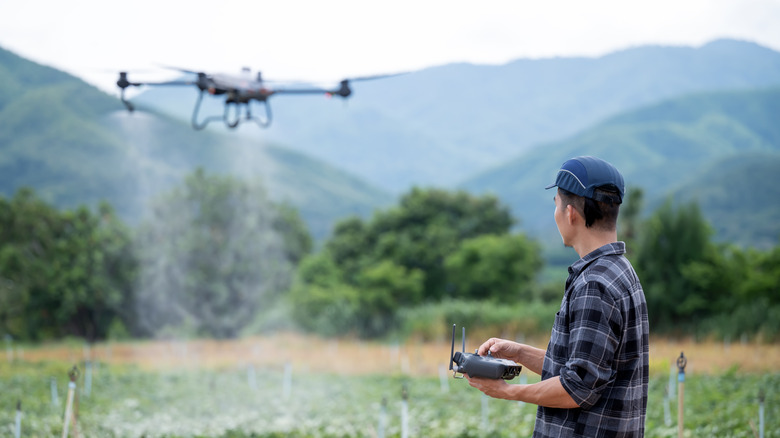How To Avoid Getting Into Trouble When Flying Your Drone
Drones are just about everywhere these days, and it's not hard to figure out why. These flying machines are fun to use, soaring around at impressive heights and speeds. Some, like the revolutionary DJI Flip, are especially impressive, being able to capture high-quality images and video and be used with the aid of a smartphone, among other noteworthy features. As a result, it's no surprise why they've also become business favorites, being used professionally for music videos, advertisements, and more. With that said, there's more to drone ownership and use than just buying one and powering it up for a joyride. While this technology may seem like simple fun, it's easy to fall outside the bounds of the law while using it.
As enjoyable as it can be to own and use a drone, it's entirely possible to use it irresponsibly — and end up on the wrong side of the law as a result. Per the Federal Aviation Administration, drones are legal for anyone to fly, but there are strict guidelines regarding how they are to be used. If you want to get into drone flying in any capacity, these are incredibly important guidelines to be aware of. After all, if you're found to be in violation of the FAA's rules, you can have your commercial drone pilot certification revoked or face a whopping $75,000 fine per each instance of misbehavior.
So, what do you need to know about safe, responsible, and legal drone flying? Here are the biggest things to keep in mind so you don't end up in trouble.
Time and location are crucial to responsible drone use
When it comes to being a responsible recreational drone user, the most important things to know are when and where to use it. Though drone law tends to shift a bit from state to state, there are some general guidelines that apply on a federal level users need to be aware of. As far as the times of day, you're more than able to use your drone during the daylight hours, though nighttime use requires additional lighting. Anti-collision lights must be visible from a minimum of three miles away. Also, you may need to obtain a waver for flying after sunset.
Speaking to the matter of where, theoretically, a drone can be flown just about anywhere — so long as the altitude doesn't exceed 400 feet — and landed anywhere that federal, state, or local law doesn't deem off-limits. For flight, though, there are some major exceptions. Naturally, drones shouldn't be flown near airports, locations deemed national security-sensitive, military bases, specific landmarks, or in airspace under temporary flight restrictions. While the FAA doesn't deal in privacy regulations, it does encourage those feeling unsafe or threatened by drone activity to alert law enforcement, so be respectful of others' privacy during your flights. Not to mention, there may be some local laws on the books in your area to adhere to.
This covers the broad strokes of when and where a drone can be used. To help make sure you're flying in the right area at the right time, some handy apps for drone users are worth installing. What's also worth considering are the specifics of your drone and the associated paperwork to keep things legal.
What constitutes a legal drone and drone user?
For legal drone use, FAA registration is required for recreational drones weighing more than half a pound, as well as all commercially-used units. The registration number must be prominently displayed on the exterior of the drone. Also, commercial drones under 55 lbs must fly under FAA guideline Part 107, which gives you permission to use your drone for business activities. To become a legal commercial drone pilot, you must be over 16 years old, physically and mentally capable of flying a drone, fluent in English, and score a passing grade on the Unmanned Aircraft General – Small (UAG) exam. The FAA outlines further requirements to get you where you need to be.
Expanding on the FAA's drone weight regulations, you'll have to jump through some additional hoops if your drone exceeds the 55-lb threshold. Drones of this size don't fall under Part 107 guidelines, so airworthiness certification found under the FAA's 49 USC 44807 might be necessary. If you have a drone of such size, it's for the best to consult the proper authorities on the matter before use. After all, it's better to be safe than sorry. It should also be said that there's a speed limit of 100 miles per hour for drones that fall under Part 107, so even as a drone pilot, it's important to obey speed laws.
Whether you opt for a store-bought model, a modified used one, or even attempt to build a drone from a Raspberry Pi, drone safety, legality, and etiquette are of the utmost importance. So long as you keep the aforementioned rules and regulations in mind, though, you shouldn't get into any trouble.


